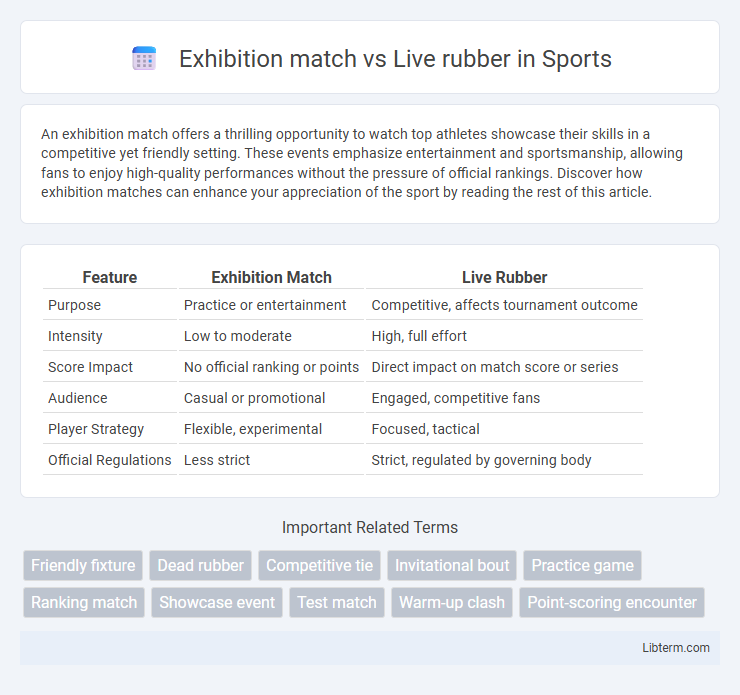An exhibition match offers a thrilling opportunity to watch top athletes showcase their skills in a competitive yet friendly setting. These events emphasize entertainment and sportsmanship, allowing fans to enjoy high-quality performances without the pressure of official rankings. Discover how exhibition matches can enhance your appreciation of the sport by reading the rest of this article.
Table of Comparison
| Feature | Exhibition Match | Live Rubber |
|---|---|---|
| Purpose | Practice or entertainment | Competitive, affects tournament outcome |
| Intensity | Low to moderate | High, full effort |
| Score Impact | No official ranking or points | Direct impact on match score or series |
| Audience | Casual or promotional | Engaged, competitive fans |
| Player Strategy | Flexible, experimental | Focused, tactical |
| Official Regulations | Less strict | Strict, regulated by governing body |
Understanding Exhibition Match vs Live Rubber
Exhibition matches are non-competitive games played primarily for entertainment, practice, or charity purposes where outcomes do not affect official rankings or tournament progression. Live rubbers, on the other hand, are critical matches within team tennis competitions such as the Davis Cup and Fed Cup, directly influencing the overall tie result and contributing to player rankings. Understanding the difference between exhibition matches and live rubbers is essential for grasping the stakes, player intensity, and strategic approaches involved in each format.
Key Differences Between Exhibition Matches and Live Rubbers
Exhibition matches are non-competitive events designed for entertainment, often featuring players of varying skill levels without affecting official rankings or tournament results. Live rubbers are competitive matches played within the context of a tournament or team competition, directly impacting standings and player statistics. The primary distinction lies in the stakes and official significance, with live rubbers influencing career records and exhibition matches serving as practice or promotional events.
Purpose and Importance in Competitive Sports
Exhibition matches serve as non-competitive events designed to showcase skills, entertain audiences, and allow players to experiment with strategies without affecting rankings. Live rubber matches carry significant importance in competitive sports as they determine outcomes in ongoing tournaments, directly impacting player standings and progression. The purpose of live rubbers is to maintain the integrity and competitive spirit of the sport, ensuring meaningful results that influence championships and athlete careers.
Audience Engagement: Exhibition vs Live Rubber
Exhibition matches typically emphasize entertainment value, offering a relaxed atmosphere that encourages audience interaction through unique formats and spontaneous moments. Live rubber matches, being part of official tournaments or series, generate intense audience engagement driven by high stakes and competitive tension, often resulting in heightened emotional investment and vocal support. The dynamic energy in live rubbers fosters a deeper connection between players and spectators, enhancing overall viewing experience compared to the more casual exhibition setting.
Impact on Player Rankings and Statistics
Exhibition matches do not affect player rankings or official statistics, as they are typically non-competitive and intended for practice or entertainment purposes. Live rubber matches in professional tournaments contribute directly to player rankings, impacting their standings by awarding or deducting ranking points based on match outcomes. Rankings and statistical records are influenced solely by live rubbers, reflecting player performance in recognized competitive events.
Pressure and Performance: Contrasts and Comparisons
Exhibition matches present lower pressure environments, allowing athletes to experiment and showcase skills without the stakes of ranking points or prize money, fostering a more relaxed performance. Live rubbers, integral to team competitions like Davis Cup or Fed Cup, impose high-pressure conditions as each point can determine the outcome of the tie, significantly impacting player focus and mental resilience. Performance in live rubbers often intensifies due to crowd expectations and national pride, amplifying psychological stress compared to the relatively casual atmosphere of exhibition events.
Notable Examples from Tennis and Other Sports
Exhibition matches in tennis, such as the famous 2010 Lakers vs. Celtics charity game, serve entertainment and promotional purposes without affecting official rankings, contrasting with live rubber matches in Davis Cup ties that directly influence team progression and player records. In football, exhibition matches like the annual MLS All-Star Game showcase talent and fan engagement without competitive stakes, whereas live rubber fixtures, such as World Cup qualifiers, determine advancement and national rankings. These distinctions highlight the strategic and competitive significance of live rubbers versus the entertainment-driven, non-binding nature of exhibitions across sports.
Media Coverage and Commercial Value
Exhibition matches often generate significant media coverage due to their star-studded lineups and entertainment-focused nature, attracting casual viewers and boosting broadcast ratings. Live rubber matches in professional tournaments carry high commercial value because of their competitive stakes, driving intense fan engagement and lucrative sponsorship deals. Sponsors and broadcasters prioritize live rubbers for advertising opportunities, leveraging the heightened viewer interest and real-time audience interaction.
Strategic Approaches in Exhibition Matches vs Live Rubbers
Exhibition matches prioritize experimental strategies, focusing on skill development and testing new techniques without the pressure of ranking points, allowing players to take calculated risks and adapt freely. In live rubbers, strategic approaches are driven by the competitive stakes, emphasizing consistency, mental resilience, and tactical discipline to secure crucial points for the team's overall success. Players tailor their game plans in live matches to exploit opponents' weaknesses and manage momentum, contrasting with the more flexible and exploratory nature of exhibition play.
Conclusion: Choosing the Right Format for Maximum Impact
Exhibition matches offer controlled environments ideal for player exposure and testing strategies without ranking consequences, attracting casual fans and sponsors. Live rubbers deliver high-stakes competition with ranking points and intense crowd engagement, appealing to serious spectators and players focused on career progression. Selecting the right format depends on balancing audience engagement, player objectives, and promotional goals to maximize impact and achieve desired outcomes.
Exhibition match Infographic

 libterm.com
libterm.com